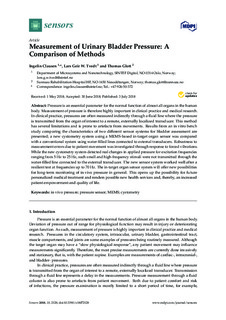| dc.contributor.author | Clausen, Ingelin | |
| dc.contributor.author | Tvedt, Lars Geir Whist | |
| dc.contributor.author | Glott, Thomas | |
| dc.date.accessioned | 2018-11-14T07:16:17Z | |
| dc.date.available | 2018-11-14T07:16:17Z | |
| dc.date.created | 2018-11-12T15:19:17Z | |
| dc.date.issued | 2018 | |
| dc.identifier.citation | Sensors. 2018, 18 (7), pp12 | nb_NO |
| dc.identifier.issn | 1424-8220 | |
| dc.identifier.uri | http://hdl.handle.net/11250/2572452 | |
| dc.description.abstract | Pressure is an essential parameter for the normal function of almost all organs in the human body. Measurement of pressure is therefore highly important in clinical practice and medical research. In clinical practice, pressures are often measured indirectly through a fluid line where the pressure is transmitted from the organ of interest to a remote, externally localized transducer. This method has several limitations and is prone to artefacts from movements. Results from an in vitro bench study comparing the characteristics of two different sensor systems for bladder assessment are presented; a new cystometry system using a MEMS-based in-target organ sensor was compared with a conventional system using water-filled lines connected to external transducers. Robustness to measurement errors due to patient movement was investigated through response to forced vibrations. While the new cystometry system detected real changes in applied pressure for excitation frequencies ranging from 5 Hz to 25 Hz, such small and high-frequency stimuli were not transmitted through the water-filled line connected to the external transducer. The new sensor system worked well after a resilient test at frequencies up to 70 Hz. The in-target organ sensor system will offer new possibilities for long-term monitoring of in vivo pressure in general. This opens up the possibility for future personalized medical treatment and renders possible new health services and, thereby, an increased patient empowerment and quality of life | nb_NO |
| dc.language.iso | eng | nb_NO |
| dc.rights | Navngivelse 4.0 Internasjonal | * |
| dc.rights.uri | http://creativecommons.org/licenses/by/4.0/deed.no | * |
| dc.title | Measurement of urinary bladder pressure: A comparison of methods | nb_NO |
| dc.type | Journal article | nb_NO |
| dc.type | Peer reviewed | nb_NO |
| dc.description.version | publishedVersion | nb_NO |
| dc.source.pagenumber | 12 | nb_NO |
| dc.source.volume | 18 | nb_NO |
| dc.source.journal | Sensors | nb_NO |
| dc.source.issue | 7 | nb_NO |
| dc.identifier.doi | 10.3390/s18072128 | |
| dc.identifier.cristin | 1629603 | |
| dc.relation.project | Norges forskningsråd: 248001 | nb_NO |
| cristin.unitcode | 7401,90,31,0 | |
| cristin.unitname | Mikrosystemer og nanoteknologi | |
| cristin.ispublished | true | |
| cristin.fulltext | original | |
| cristin.qualitycode | 1 | |

